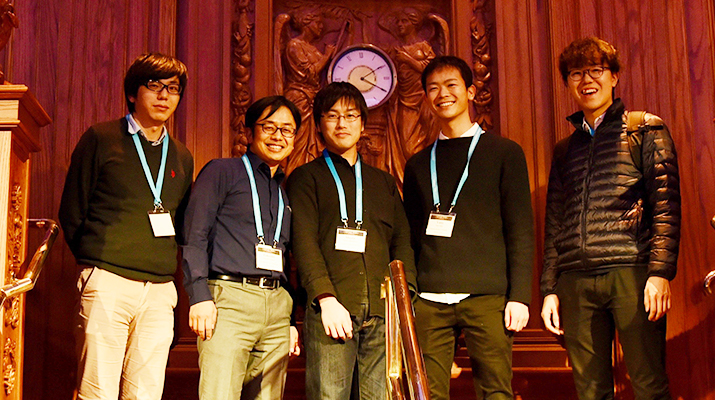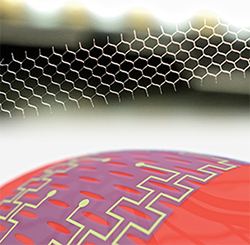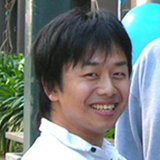
ここからコンテンツです。

Ultrastretchable and deformable bioprobes using "Kirigami" designs
Revolutionizing electronics technology with the Japanese art of paper cutting By Takeshi Kawano
A research team in the Department of Electrical and Electronic Information Engineering and the Electronics-Inspired Interdisciplinary Research Institute (EIIRIS) at Toyohashi University of Technology has developed an ultrastretchable bioprobe using a 'Kirigami' design. The Kirigami-based bioprobe enables one to follow the shape of spherical and large deformable biological samples such as heart and brain tissues. In addition, its low strain-force characteristic reduces the force induced on organs, thereby enabling minimally invasive biological signal recording.
High stretchability and deformability are very desirable properties when one seeks to increase the applications of flexible film electronics including sensors, actuators, and energy harvesters. In particular, these properties have great potential for applications related to three-dimensional soft biological samples such as organs and tissues that exhibit large and rapid changes in their surface area and volume (e.g., a beating heart). However, conventional elastomer-based stretchable devices require a large strain-force to fully stretch due to their intrinsic material properties. This makes it impossible to follow the deformation of soft biological tissues, thereby preventing natural deformation and growth. For device applications pertaining to soft biological samples, it is extremely important to reduce the strain-force characteristic of the stretchable devices to realize low invasiveness and safe measurements.
A research team in the Department of Electrical and Electronic Information Engineering and the EIIRIS at Toyohashi University of Technology has developed an ultrastretchable bioprobe using Kirigami designs.
"In order to create an ultrastretchable bioprobe with low strain-force characteristic, we used a Kirigami design as the device pattern. The remarkable feature of Kirigami is that rigid and unstretchable materials can be rendered more stretchable compared to other elastomer-based stretchable materials. The stretching mechanism is based on an out-of-plane bending of the thin film rather than stretching of the material; therefore, the strain-stress characteristic is extremely low compared to that of elastomer-based stretchable devices," explains the first author of the article, Ph.D. candidate Yusuke Morikawa.

The leader of the research team, Associate Professor Takeshi Kawano, said, "The idea germinated in my mind one morning when I woke up and saw my son playing with Origami and Kirigami. I saw him realize high stretchability of the paper while creating the Kirigami designs. This made me wonder whether it is possible to develop stretchable electronics using the concept of Kirigami. Surprisingly, our preliminary studies on Kirigami-based parylene films by microelectromechanical systems technology exhibited high stretchability of 1,100%. In addition, we are extremely excited that the fabricated Kirigami-based bioprobes possess the distinct advantages of high stretchability and deformability, and are capable of recording biological signals from the cortical surface and beating heart of a mouse."
The research team believes that the Kirigami-based bioprobes can also be used to probe tissues and organs that exhibit time-dependent changes in their surface and volume due to growth or disease. This is expected to lead to the eventual realization of a completely new measurement method that can be instrumental in understanding the mechanisms governing growth and diseases like Alzheimer’s.
This work was supported by Grants-in-Aid for Scientific Research (A) (No. 25249047), (B) (No. 17H03250), for Young Scientists (A) (No. 26709024), the PRESTO Program from JST, and Strategic Advancement of Multi-Purpose Ultra-Human Robot and Artificial Intelligence Technologies program from NEDO. Y.M. was supported by the Leading Graduate School Program R03 of MEXT. R. N. was also supported by Takeda Science Foundation.
Reference
Yusuke Morikawa, Shota Yamagiwa, Hirohito Sawahata, Rika Numano, Kowa Koida, Makoto Ishida and Takeshi Kawano (2017). Ultrastretchable Kirigami bioprobes. Advanced Healthcare Materials,
http://dx.doi.org/10.1002/adhm.201701100
切り紙がエレクトロニクス技術を変える
切り紙構造による超伸縮性バイオプローブデバイスBy 河野 剛士
豊橋技術科学大学電気・電子情報工学系とエレクトロニクス先端融合研究所の研究チームは、切り紙構造を用いた超伸縮性神経電極を開発しました。切り紙神経電極は、複雑な三次元形状を持ち、また、大きな変形を示す心臓や脳組織などの生体サンプルに対して、その変形に沿って伸縮することを可能とします。加えて、伸縮に必要な力を低減できる特徴は、生体サンプルに対するデバイスの圧迫を抑えて、これまでにない低侵襲な生体信号の計測を可能とします。
デバイスの高い伸縮性と高い変形性は、これまでのセンサやアクチュエータ、エナジーハーベスタといったエレクトロニクスの応用をさらに拡大することが期待されます。特に、三次元的な形状を持ち、速くて大きな変形を示す臓器(例えば心臓)や組織といった各種の生体サンプルへの応用が期待されます。しかし、ゴムのような弾性材料を基にした従来の伸縮性デバイス(ストレッチャブルデバイス)では材料自体の特性によってデバイスの伸縮時に大きな力が必要でした。そのため、従来のストレッチャブルデバイスは、柔らかい生体サンプルに対して追従することはできず、また、生体の自由な変形や成長を阻害する可能性もありました。柔らかい生体組織へのストレッチャブルデバイスの応用には、デバイスの低侵襲性や安全な計測を実現する上で伸縮に必要な力を最小限に抑えることが重要な課題でありました。
そこで、研究チームは切り紙構造を用いて超伸縮性を実現したバイオプローブ(神経電極)デバイスを開発しました。
「微小な応力で伸縮可能な伸縮性神経電極を実現するために、我々は切り紙構造をデバイスの基盤として使いました。切り紙構造の驚くべき特徴は、硬く、伸縮性を持たない材料に対しても切り紙構造を適用することで、他の弾性材料を用いるより、むしろ高い伸縮性が実現できることです。これは、切り紙構造における伸縮性が材料の伸縮ではなく、薄いフィルムの三次元的な曲げによって生じているからです。そのため、伸縮に必要な力は弾性材料を用いた伸縮性デバイスと比較しても遥かに小さくなります。」と筆頭著者である博士後期課程の森川雄介は説明します。
研究チームのリーダーである河野剛士准教授は「このアイデアは実は、朝起きたときに折り紙や切り紙をして遊んでいる息子を見てひらめきました。彼は高い伸縮性を持ったフィルムを、紙を使って実現していました。それを見て私は、切り紙のコンセプトを用いた伸縮性エレクトロニクスができるのではないかと考えました。驚いたことに、予備実験として行った、パリレンに微細パターンを施して製作した切り紙フィルムは1,100%という革新的な伸縮性を実現しました。また、次に製作した切り紙神経電極デバイスが、高い伸縮性と変形性といった特性を活かして、マウスの大脳皮質と拍動する心臓からの神経信号記録を実現したことにも驚かされました。」
研究チームは、切り紙神経電極が長期における成長や病気などによる組織や臓器の表面積ないしは体積の増加・減少を伴う状況でも適用可能であると考えています。最終的には、これまでにない新たな計測手法を実現し、成長やアルツハイマーに代表される脳の変形を伴うような病気についてのメカニズムの解明や治療に役立てていきたいとも考えています。
本研究は、文部科学省・日本学術振興会科学研究費基盤研究A(25249047)、基盤研究B(17H03250)、若手研究A(26709024)、科学技術振興機構さきがけ(PRESTO)、及び国立研究開発法人新エネルギー・産業技術総合開発機構(NEDO)次世代人工知能・ロボット中核技術開発の助成によって実施しました。また、筆頭著者の森川は文部科学省・日本学術振興会の実施する博士課程教育リーディングプログラム(R03)の支援を受けました。また共著者沼野は公益財団法人武田科学振興財団の支援を受けました。
Researcher Profile

| Name | Takeshi Kawano |
|---|---|
| Affiliation | Department of Electrical and Electronic Information Engineering |
| Title | Associate Professor |
| Fields of Research | Micro/Nano Devices, Neural Interface Devices |
ここでコンテンツ終わりです。
